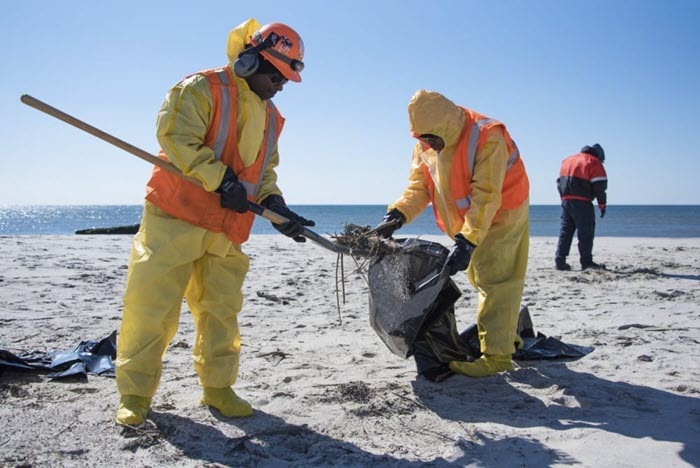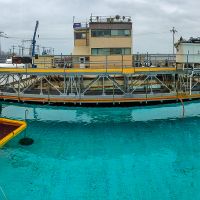
OR&R Provides Leadership to Federal Oil Spill Research Efforts
After the Exxon Valdez oil spill in 1989, advancing oil pollution research and technology to limit the environmental impacts of oil spills became a national and international priority. Congress responded by enacting the Oil Pollution Act of 1990 and forming ICCOPR—the Interagency Coordinating Committee on Oil Pollution Research. ICCOPR’s mission is to coordinate research for preventing, planning for, responding to, and mitigating the effects of oil pollution on the environment.
Among ICCOPR’s areas of focus are in-situ burning, UAS (uncrewed aircraft systems)/UAV (uncrewed aerial vehicles), remote sensing, emerging fuels, Arctic issues, and fresh-water issues. Additional collaboration occurs in testing at oil spill facilities, such as the Bureau of Safety and Environmental Enforcement’s (BSEE) National Oil Spill Response Research & Renewable Energy Test Facility (often referred to by its former name, the Oil and Hazardous Materials Simulated Environmental Test Tank, or OHMSETT); the Army Corps of Engineers’ Cold Regions Research and Engineering Lab; and various Arctic locations.
Within ICCOPR, 16 federal agencies provide a collaborative approach to address federal oil pollution research needs. In the past, the vice chair role was a two-year commitment and rotated between a trio of agencies: NOAA OR&R, Bureau of Safety and Environmental Enforcement, and the Environmental Protection Agency. In 2021, NOAA became the permanent Vice Chair agency and the Chief of OR&R’s Emergency Response Division rotated into the Vice Chair position.
ICCOPR has been a forum for OR&R scientists to share findings on research such as the natural resource injury studies associated with the Deepwater Horizon Oil Spill Natural Resource Damage Assessment; ongoing development work associated with NOAA’s oil trajectory and fate models, comprising the GNOME suite of tools; awards and funding opportunities from the NOAA Restore Act Science Program; research completed by NOAA's National Centers for Coastal Ocean Science; remote sensing studies funded by the Bureau of Safety and Environmental Enforcement; NOAA training opportunities in oil and chemical spill response and planning; and support that OR&R provides during hurricanes (i.e., common operating picture, data sharing, and marine debris and pollution source identification). Other research presentations include enhancements to ERMA® (Environmental Response Management Application), along with several projects working with the U.S. Coast Guard (USCG) Great Lakes Center of Expertise to develop a TAP (Trajectory Analysis Planner) analysis which will aid response agencies with contingency planning in the Great Lakes region.
To help achieve its goal of coordinating federal research efforts on oil pollution topics, ICCOPR published a Research and Technology Plan (for the first time in 2015), to guide the oil pollution research efforts and funding priorities of the member agencies and inform others working in the oil pollution research field of federal interests and priorities. Updates to the Plan have been released over the years, most recently, the 2022-2027 Research and Technology Plan (R&T Plan). You can learn more about the ICCOPR efforts to reinvent the R&T Plan in the International Oil Spill Conference paper, Evolution of Federal Oil Pollution Research Planning.
Following the Deepwater Horizon industrial disaster, the R&T Plan review period was changed from every 10 years to every six years, with the latest review completed in 2021. Under the USCG Authorization Act of 2020, the National Academies of Sciences, Engineering, and Medicine (NASEM) was contracted to review the R&T Plan for 2022-2027, establishing a review committee to provide advice and guidance on the approach and structure of the 2022-2027 plan, assess its adequacy, and provide guidance regarding its implementation. NASEM’s recent review consisted of an 18-month congressionally-mandated study, completed in March 2023 by a panel of eight experts, on the interwoven topics of prevention, preparedness, response, restoration, and injury assessment.
Recommendations from the latest review include developing an Oil Pollution Research Dashboard, broadening engagement during plan development, including a communication/collaboration strategy. The review also includes ways to measure action outputs to measure implementation of updates within the R&T Plan, as well as a few fundamental obstacles (e.g., funding/resources, lack of a strategy for funding, definition of mitigation needs, and timing of research). The review also commented on the lack of an ability to obtain authorization to conduct field testing under the current legislation for experimental purposes in the U.S. and how, without “spills of opportunity” occurring, no such research can be conducted.
Overall, the recommendations in the review will assist ICCOPR in developing its R&T Plan that can be widely used to promote progress, coordination, and collaboration on priority oil pollution research needs within the U.S. and globally—research needs that are important for improving knowledge, capacity, and regulations to safeguard the environment.
For More Information Visit:
Interagency Coordinating Committee on Oil Pollution Research Meeting, September 16, 2019
For more information contact:
Aaron.Parker@noaa.gov, ICCOPR Vice Chair; Chief of NOAA OR&R Emergency Response Division
Status
Home | OR&R Research Projects | OR&R Provides Leadership to Federal Oil Spill Research Efforts

